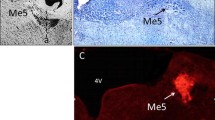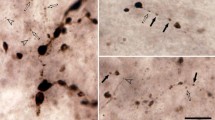Abstract
The aim of the present study was to examine the physiological consequences of a unilateral infraorbital nerve lesion and its regeneration at different levels of the somatosensory neuraxis. In animals whose right infraorbital nerve had been crushed, a large unresponsive area was found in the main brainstem trigeminal nucleus (Pr5). Responses evoked by ipsilateral vibrissal deflection in the middle of Pr5 reappeared only on days 22–35 after the nerve had been transected, whereas recovery from the nerve crush took only 7–9 days. However, no sign of short-term neuronal plasticity was observed in Pr5 after peripheral nerve injury. An enlargement of the receptive fields in two-thirds of the units and a lengthening in the delay of the evoked responses were observed as long-term plastic changes in Pr5 neurons after peripheral-nerve regeneration. In the ventral posteromedial nucleus of the thalamus (VPM) of partly denervated animals, however, only minutes or hours after the nerve crush, certain units were found to respond in some cases not only to the vibrissae, but also to mechanical stimulation of the face over the eye (two units), the nose (one unit), and the midline (one unit). Apart from the experiments involving incomplete denervation, the vibrissal representation areas of the VPM were unresponsive to stimulation of both the vibrissae and other parts of the face until nerve regeneration had occurred. In the somatosensory cortex, an infraorbital nerve crush immediately resulted in a large cortical area being unresponsive to vibrissal deflection. It was noteworthy, however, that shortly after the nerve crush, this large unresponsive whisker representation cortical area was invaded from the rostromedial direction by responses evoked by stimulation of the forepaw digits. In spite of the reappearance of vibrissa-evoked responses 7–10 days after the nerve crush, an expanded digital representation could still be observed 3 weeks after the nerve crush, resulting in an overlapping area of digital and vibrissal representations. The withdrawal of the expanded representation of forepaw digits was completed by 60 days after the nerve crush. The results obtained in Pr5, the VPM, and the cortex strongly suggest that the higher the station in the neuraxis, the greater the degree of plasticity after infraorbital nerve injury.
Similar content being viewed by others
Author information
Authors and Affiliations
Additional information
Received: 28 May 1998 / Accepted: 5 January 1999
Rights and permissions
About this article
Cite this article
Kis, Z., Farkas, T., Rábl, K. et al. Comparative study of the neuronal plasticity along the neuraxis of the vibrissal sensory system of adult rat following unilateral infraorbital nerve damage and subsequent regeneration. Exp Brain Res 126, 259–269 (1999). https://doi.org/10.1007/s002210050735
Issue Date:
DOI: https://doi.org/10.1007/s002210050735




